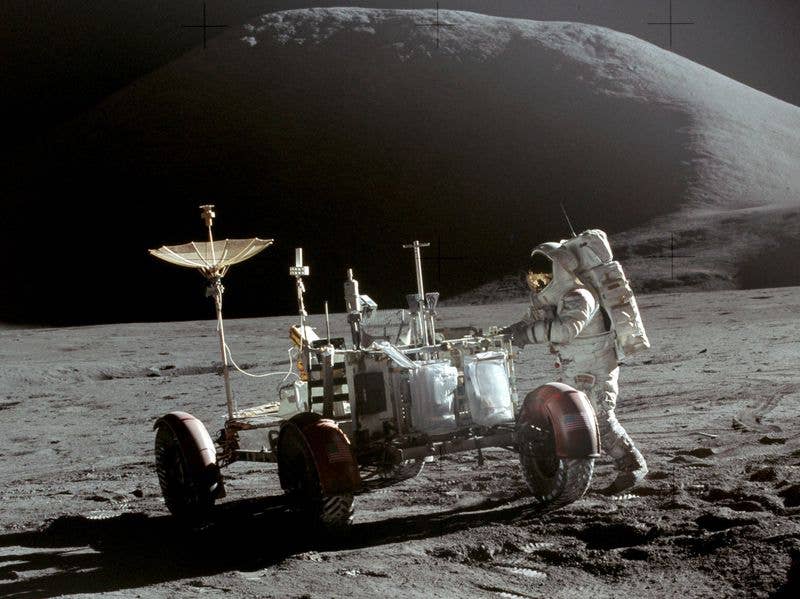A Toyota On The Moon: BT, DT
It’s high time someone proposed an updated version of the GM rovers we parked at Taurus-Littrow 50 years ago. It better have the same warranty.

If you ask anyone who has done it what the overwhelming challenge of developing a new airplane is, it won’t have to do with weight, a suitable powerplant or lift and drag, but where the money is coming from to pay for it. That’s the first thing I thought of when I saw Toyota’s proposed Lunar Cruiser. If Toyota can invest millions in the sketchy world of urban air mobility, they can surely develop a vehicle to drive on the moon.
Watching how they’re going to get it up there, however, makes me want to dash to the store to lay-in a gross of popcorn. If NASA ever gets its new Space Launch System booster off the pad, the eventual cargo version of it is supposed to be capable of 46 tons to translunar injection, so I guess that would work if we can figure out who’s writing the checks. Same for the SpaceX Starship. Call me a pessimist, but I somehow sense the Ruskies and the Chinese aren’t gonna want to go halfsies this time.
Given the hot market for used cars, however, perhaps there’s a missed opportunity. Already on the Moon with the keys in the ignition are three lightly used, barely driven all-lurain vehicles ready to rock. Two need a little body work and all need fresh batteries, but the price is right. I’m talking about the three Lunar Roving Vehicles the Apollo astronauts hauled up there between 1971 and 1972. Toyota’s announcement caught me just as I was finishing Earl Swift’s “Across the Airless Wilds: The Lunar Rover and the Triumph of the Final Moon Landings.” This fascinating history of an Apollo sub-program was published last summer and had been idling on my reading list. Toyota is standing on the shoulders of giants because the lunar car idea was one of man’s more remarkable achievements.
I followed the Apollo program in real time, but just as Apollo 8 surprised and stunned me, so did the rovers. When the first one launched with Apollo 15 in July of 1971, I remember wondering how the hell they could even do that and how it could possibly work. But it did. Brilliantly, too. As Swift reveals, the lunar car idea had been around for a long time and was popularized by no less than Werhner von Braun in a 1952 Collier’s magazine article. That was just seven years after von Braun had been scooped up at the end of World War II and bundled off first to Fort Bliss, then eventually Huntsville to organize what became NASA’s Marshall Space Flight Center. Marshall rode herd on the rover project until the flight hardware was ready.
The rover idea had been perking through the 1960s, but not much definite came of it until the fall of 1969—three months after the first lunar landing in July of that year and as NASA contemplated the so-called Apollo J missions, which envisioned longer stays on the surface and more detailed science. That would mean the rickshaw cart Alan Shepard and Edgar Mitchell dragged around Frau Mauro wouldn’t do. As late as early 1969, NASA was still considering the Bell Aerosystems rocket belt as a means of lunar transportation. Saner heads prevailed and in October, Boeing was awarded a contract for four rovers, including three flight versions, one for parts and various models, including a 1G version for earth training. The first flight-capable rover had to be ready for Apollo 15 in mid-1971.
During the conceptual years, a number of designs were tried or contemplated, including a six-wheeled articulated version similar to the image of the proposed Toyota Lunar Cruiser. It was ruled out as too complex and too heavy and requiring a dual-launch approach to the landings, which NASA rejected to reduce costs. Before Neil Armstrong took his epic giant leap, no one knew what the lunar regolith was really like and what would be required to walk on it, much less drive on it.
A Polish immigrant engineer with the rarified skill of expertise in vehicle traction on difficult surfaces, Mieczysław Gregory Bekker, was instrumental in fleshing out a light, battery-powered four-wheel rover design. Another immigrant, Hungarian Ferenc Pavlics, joined him at a GM developmental skunkworks in Santa Barbara, California. Pavlics came up with the light, but resilient, wire mesh wheel design that ultimately delivered bulletproof performance in the lunar surface. The GM division, formally called the General Motors' Defense Research Laboratories, provided the wheels, motors and suspension to Boeing as a subcontractor. NASA's Saverio “Sonny” F. Morea oversaw the project, having successfully done the same for the legendary F-1 engines used in the Saturn V booster.
The whole rover shebang was supposed to weigh no more than 400 pounds (66 pounds in lunar gravity), but like any aerospace project, it gained weight, finally grossing at 460 pounds. That was partially because NASA kept adding requirements, such as a TV camera. Those numbers are remarkable for two reasons. One, that between the G landing mission of Apollo 11 and the first J mission, NASA found a way to accommodate an additional nearly 500 pounds in a vehicle tight on descent-stage fuel capacity. Every additional pound cost precious seconds of fuel. (One way they did this was to insert a Descent Orbital Insertion burn to lower the altitude at which the LM separated, requiring less descent fuel.) Second, that 460 pounds had to, and did, carry an additional 1000-pounds-plus of astronauts, tools and lunar samples. And it had to, and did, as Swift details, fold up and fit into the wedge-shaped Quadrant 1 of the LM descent stage. It was deployable with a simple lanyard operated by one astronaut.
The LRVs had a piddling amount of power, given the payload they were expected to carry. They had 36-volt silver-zinc potassium hydroxide batteries with a total capacity—wait for it—of 4.3 kwH—about 6 percent what a Tesla Model 3 has. They were cooled with wax that absorbed heat, then rejected it when the wax resolidified in the cold shade. Each 32-inch wheel had its own 0.25-HP motor and both the front and rear wheels could be steered together or separately. Even with that anemic power, the ever-adventurous Gene Cernan got LRV 3 up to 11 MPH on the final Apollo 17 mission.
Despite a breakneck 17-month developmental schedule, the rover technology was tested more extensively than I had imagined, according to Swift’s book. It was running significantly over budget and the schedule was slipping. Desperate to get the astronauts starting on training, NASA’s Don Beattie, who oversaw the lunar surface experiments, contacted Rutledge Mills at the U.S. Geological Survey and asked if he could help. He could. Mills got some Polaroids—remember them?—of the LRVs under construction and cobbled together the “Grover,” a quick-and-dirty rover trainer that used suspension from a Morris Minor and surplus landing gear motors from a B-26. The astronauts eventually got a 1G trainer version and even trained with it weightlessly in the agency’s parabola flight aircraft.
By the standards of the day and even in retrospect, NASA gave the astronauts a surprisingly long leash in using the rovers to stray from their LM. The rule was to drive no farther than they could walk back in case the vehicle broke. None of them did. And on Apollo 17, Cernan and Harrison Schmitt strayed 4.6 miles from the LM. The LRV drove 22 miles in 4 hours and 26 minutes of drive time. Navigating the surface proved challenging and dangerous because the harsh lighting makes distances difficult to judge and hides the edges of craters. “You could really get lost here,” Apollo 15’s James Irwin remarked to Houston from Hadley Rille.
Other than losing a fender due to astronaut clumsiness, the rovers performed flawlessly better than anyone might have expected. They vastly expanded the radius of the J missions and truly made them explorations of serious science. Said Swift: “Were the machines worth their expense, not to mention the heartache and stress of their hell-for-leather creation inspired? No argument, they didn’t come cheap. Including the price of development, each of those 56 miles cost something in the neighborhood of $680,000 or $4 million in today’s money.”
Now comes the question of whether Toyota can find the same kind of will—not to mention the money—that NASA, Boeing and GM did in that crowded hour between the fall of 1969 and 1971, when Dave Scott pulled the lanyard to release LRV 1. The Toyota Cruiser will actually be the same kind of mobile habitat Wernher von Braun envisioned those many years ago. And they’ll power it with the same kind of hydrogen fuel cell they’re already selling in the Mirai hydrogen-powered sedan.
What’s most astonishing to me is why we haven’t done this already. If Toyota meets the 2040 deadline, it’ll be close to 70 years since Cernan and Schmitt parked LRV 3. Of such stuff poems aren’t exactly made. But here’s hoping.






